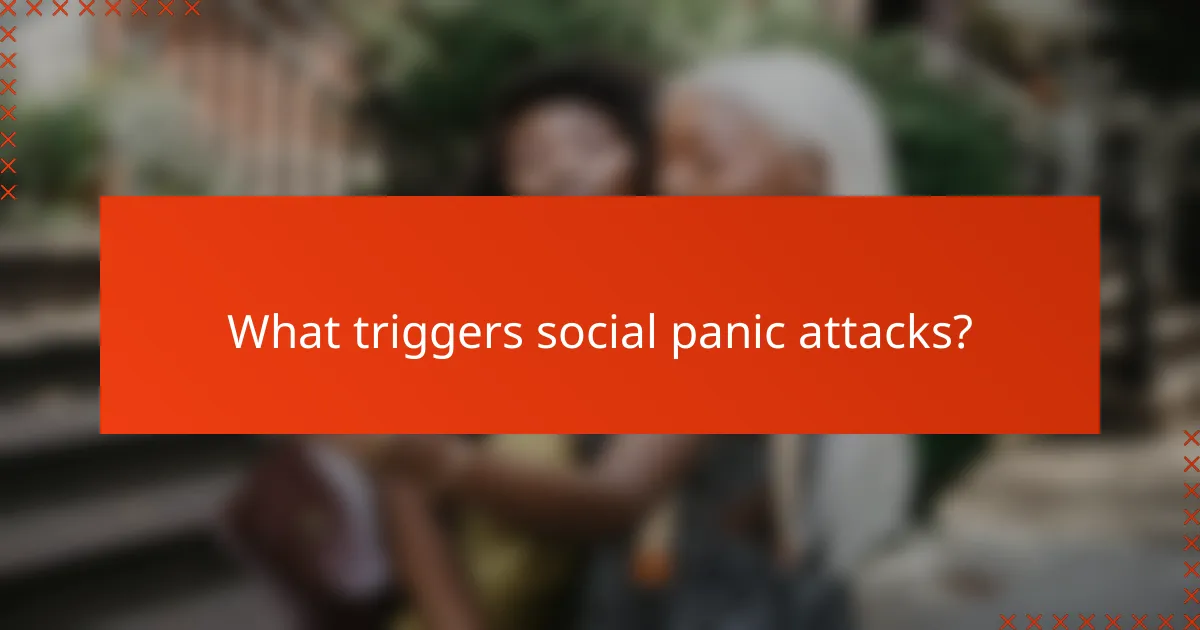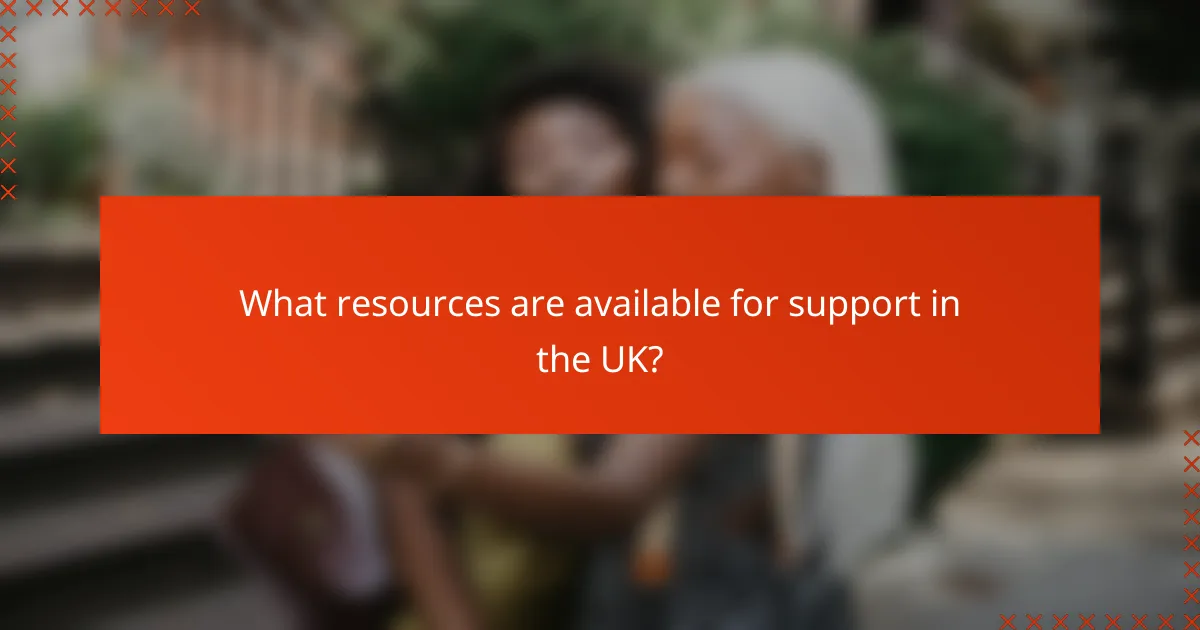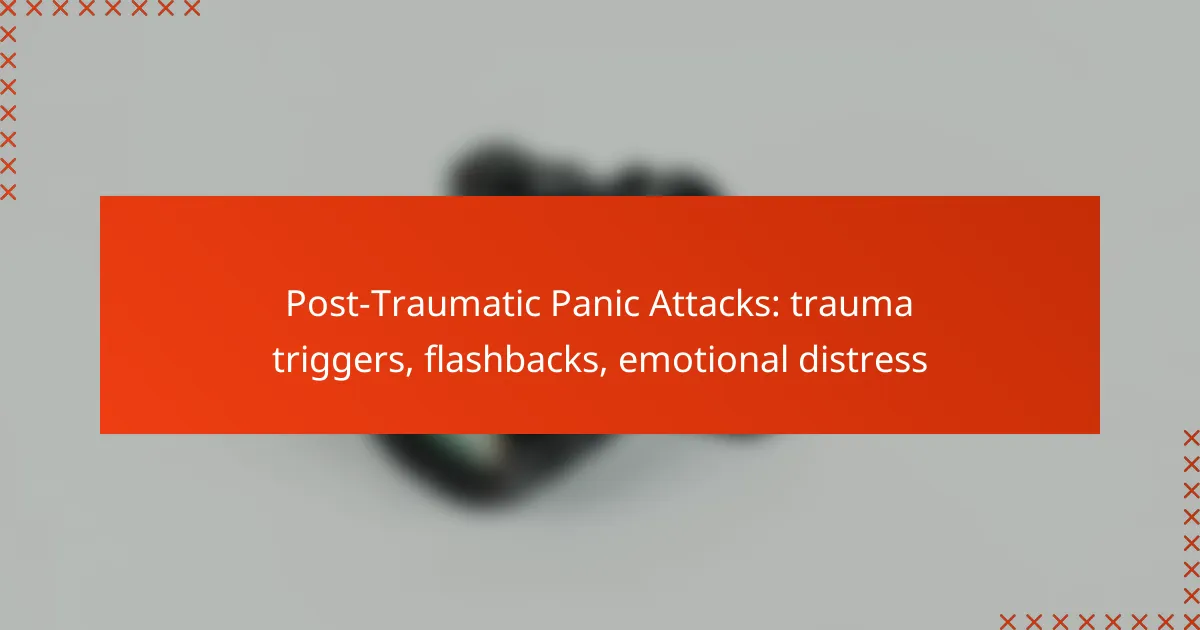Social panic attacks can be debilitating experiences characterized by intense fear and anxiety in social situations, often driven by the fear of judgment and past negative encounters. Individuals may experience physical symptoms such as increased heart rate, shortness of breath, and excessive sweating, which can hinder their ability to connect with others. Understanding these triggers and symptoms is crucial for managing anxiety and improving social interactions.

How can I manage social panic attacks in the UK?
Managing social panic attacks in the UK involves a combination of therapeutic approaches, relaxation techniques, medication, and support systems. Understanding these options can help individuals regain control over their social interactions and reduce anxiety.
Cognitive Behavioral Therapy (CBT)
Cognitive Behavioral Therapy (CBT) is a widely recognized treatment for social panic attacks. It focuses on identifying and changing negative thought patterns and behaviors that contribute to anxiety in social situations.
CBT typically involves structured sessions with a trained therapist, where individuals learn coping strategies and gradually face their fears in a controlled manner. This approach can lead to significant improvements in social confidence over time.
Mindfulness and relaxation techniques
Mindfulness and relaxation techniques can effectively reduce anxiety associated with social panic attacks. Practices such as deep breathing, meditation, and progressive muscle relaxation help calm the mind and body, making social situations feel less overwhelming.
Incorporating mindfulness into daily routines can enhance overall emotional resilience. Simple exercises, like focusing on the present moment or engaging in guided imagery, can be practiced anywhere, providing immediate relief during stressful encounters.
Medication options
Medication can be a viable option for managing social panic attacks, especially when symptoms are severe. Common medications include selective serotonin reuptake inhibitors (SSRIs) and benzodiazepines, which can help alleviate anxiety symptoms.
Consulting with a healthcare provider is essential to determine the most appropriate medication and dosage. It’s important to weigh the benefits against potential side effects and to monitor progress regularly.
Support groups in the UK
Support groups in the UK offer a valuable resource for individuals experiencing social panic attacks. These groups provide a safe environment to share experiences, learn from others, and develop coping strategies together.
Organizations such as Anxiety UK and the National Institute for Health and Care Excellence (NICE) can help locate local support groups. Participating in these communities can foster a sense of belonging and reduce feelings of isolation associated with anxiety disorders.

What triggers social panic attacks?
Social panic attacks are often triggered by a combination of factors, including the fear of judgment, past negative experiences, and high-stress environments. Understanding these triggers can help individuals manage their anxiety and navigate social situations more effectively.
Fear of judgment in social settings
The fear of judgment is a primary trigger for social panic attacks. Individuals may worry excessively about how others perceive them, leading to heightened anxiety in social interactions. This fear can manifest as a concern over making mistakes, being criticized, or not meeting social expectations.
To combat this fear, individuals can practice self-affirmation techniques and focus on their strengths. Engaging in gradual exposure to social situations can also help reduce anxiety over time, allowing individuals to build confidence in their social skills.
Past negative experiences
Negative experiences in previous social situations can significantly influence current feelings of anxiety. For instance, being embarrassed or rejected in the past can create a lasting impact, making individuals more sensitive to similar situations in the future. This can lead to a cycle of avoidance and increased fear.
Reflecting on these past experiences and reframing them positively can help individuals move forward. Seeking support from friends or professionals can also provide valuable perspectives and coping strategies to address these fears.
High-stress environments
High-stress environments, such as crowded places or unfamiliar settings, can trigger social panic attacks. The overwhelming nature of these situations can heighten feelings of anxiety and make it difficult to focus on interactions. Factors like noise, large groups, or time constraints can exacerbate this stress.
To manage anxiety in high-stress environments, individuals can develop coping strategies such as deep breathing exercises or grounding techniques. Planning ahead and familiarizing oneself with the environment can also reduce feelings of uncertainty and help ease anxiety during social interactions.

What are the physical symptoms of social panic attacks?
Physical symptoms of social panic attacks can manifest in various ways, often leading to intense discomfort during social situations. These symptoms typically include increased heart rate, shortness of breath, and excessive sweating, which can significantly impact a person’s ability to engage in social interactions.
Increased heart rate
An increased heart rate is a common physical symptom experienced during social panic attacks. This rapid heartbeat can occur suddenly and may feel like a pounding or racing sensation in the chest. It is often triggered by the body’s fight-or-flight response to perceived threats in social settings.
To manage this symptom, practice deep breathing techniques. Inhale slowly through the nose, hold for a moment, and exhale through the mouth. This can help calm the nervous system and reduce heart rate during stressful situations.
Shortness of breath
Shortness of breath is another prevalent symptom associated with social panic attacks. Individuals may feel as if they cannot catch their breath or may experience tightness in the chest. This sensation can be alarming and may exacerbate feelings of panic.
To alleviate shortness of breath, focus on controlled breathing exercises. Try to breathe in deeply for a count of four, hold for four, and exhale for four. This rhythmic breathing can help restore a sense of calm and improve oxygen flow.
Excessive sweating
Excessive sweating is a physical response that often accompanies social panic attacks, particularly in high-pressure situations. This symptom can lead to noticeable perspiration, even in cooler environments, and may cause embarrassment or self-consciousness.
To manage excessive sweating, consider wearing breathable fabrics and layering clothing to help regulate body temperature. Staying hydrated can also assist in controlling sweat levels. If sweating becomes overwhelming, consult a healthcare professional for potential treatment options.

How do social panic attacks differ from general anxiety?
Social panic attacks are characterized by intense fear and anxiety specifically triggered by social situations, unlike general anxiety, which can arise from a broader range of stressors. Individuals experiencing social panic attacks often fear judgment or embarrassment in social settings, leading to overwhelming physical and emotional symptoms.
Specific triggers related to social situations
Common triggers for social panic attacks include public speaking, meeting new people, or being observed while eating or performing tasks. These situations can provoke a fear of negative evaluation, making individuals feel vulnerable and exposed. Understanding personal triggers can help in developing coping strategies.
For instance, someone may feel anxious when attending a party where they don’t know many guests. Identifying these specific scenarios allows individuals to prepare and practice responses, reducing the likelihood of a panic attack.
Intensity of physical symptoms
The physical symptoms of social panic attacks can be quite severe, often including rapid heartbeat, sweating, trembling, and shortness of breath. These symptoms can mimic those of a heart attack, which can further escalate anxiety during social interactions. The intensity of these symptoms can vary significantly from person to person.
For example, some individuals may experience mild discomfort, while others may feel completely overwhelmed. Recognizing the signs of an impending panic attack can help individuals implement grounding techniques, such as deep breathing or focusing on their surroundings, to manage their symptoms effectively.

What are the long-term effects of untreated social panic attacks?
Untreated social panic attacks can lead to significant long-term effects, including chronic anxiety, depression, and a decline in overall quality of life. Individuals may find their ability to engage in social situations severely impaired, which can affect personal relationships and career opportunities.
Impact on daily life
The impact of untreated social panic attacks on daily life can be profound. Individuals may struggle with routine activities such as attending work, social gatherings, or even running errands. This can lead to feelings of isolation and decreased self-esteem as social interactions become increasingly daunting.
Moreover, the fear of judgment in social settings can create a cycle of anxiety, where the anticipation of panic attacks prevents individuals from participating in events they once enjoyed. This can result in missed opportunities and a diminished sense of belonging.
Development of avoidance behaviors
As social panic attacks persist, individuals often develop avoidance behaviors to cope with their fears. This can manifest as skipping social events, avoiding public speaking, or steering clear of crowded places. Such behaviors may provide temporary relief but ultimately reinforce the cycle of anxiety.
Over time, these avoidance strategies can limit personal growth and lead to a more restricted lifestyle. It is crucial to recognize these patterns early and seek support, as addressing the underlying issues can help break the cycle and improve overall well-being.

What resources are available for support in the UK?
In the UK, various resources are available to support individuals experiencing social panic attacks, including mental health services, online therapy, and local charities. These options can provide guidance, therapy, and community support to help manage symptoms and improve overall well-being.
National Health Service (NHS) services
The NHS offers a range of mental health services for individuals facing social panic attacks. You can access support through your GP, who can refer you to specialized services, including counseling and cognitive behavioral therapy (CBT).
Additionally, the NHS provides a helpline and online resources that offer information on managing anxiety and panic symptoms. These services are typically free at the point of use, ensuring that support is accessible to everyone.
Online therapy platforms
Online therapy platforms have gained popularity as flexible options for those dealing with social panic attacks. Services like BetterHelp and Talkspace connect users with licensed therapists via video calls, chats, or messaging, allowing for convenient access to support from home.
Many platforms offer subscription models, with costs varying from around £40 to £100 per week, depending on the level of service and therapist experience. This can be a practical solution for individuals who prefer anonymity or have scheduling constraints.
Local mental health charities
Local mental health charities provide valuable resources and support for individuals experiencing social panic attacks. Organizations like Mind and Rethink Mental Illness offer helplines, support groups, and workshops tailored to anxiety and panic disorders.
These charities often provide services at little to no cost, making them an excellent option for those seeking community support. Engaging with local charities can also help individuals connect with others who share similar experiences, fostering a sense of belonging and understanding.



